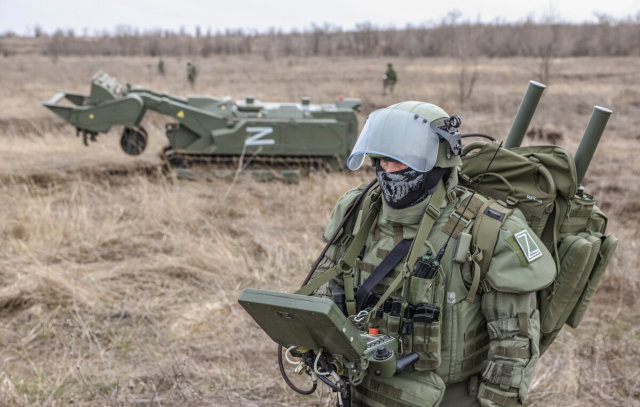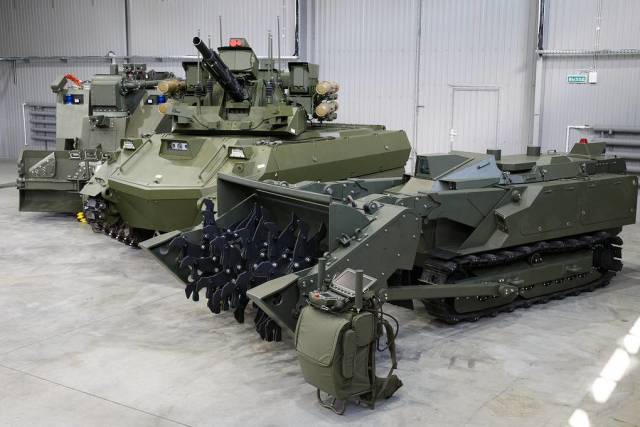The BR-1 and BRG-1 robotic platforms used in the special military operation zone for mining and medical evacuation will receive artificial intelligence (AI). According to a source in the defense industry complex of the Russian Federation, machine vision will allow them to perform tasks independently. We tell about the history of domestic combat robots and about which machines are serving in the zone of their
Sappers and paramedics
Soldiers of the Armed Forces of the Russian Federation are assisted on the front line by several types of ground-based uninhabited vehicles (NPA). One of the robotic complexes that is used for medical evacuation and cargo delivery is BRG-1. A source in the military-industrial complex told TASS about this, specifying that only one machine is being used so far, and it entered service in July of this year.
BRG-1 is able to take a wounded fighter out of the danger zone by dragging on a roll-up rescue stretcher. At the same time, the device can pull up to 250 kg and reach speeds of up to 15 km/h. The robot is equipped with a video camera, the range of communication with it is up to 5 km when using a repeater.
Another robot nurse is a universal robotic platform created by engineers of the Kaliningrad mixed martial arts club "Baltic Bears". The developers told TASS that the device can carry two wounded, as well as ammunition and other cargo. With a robot weight of 80 kg, it is capable of carrying 150 kg of payload. The control range in the open area is 3 km, in urban conditions — 800 m. Tracks are used as a propellant, which, in combination with high ground clearance, provides the device with high cross-country ability on ice, snow and sand.
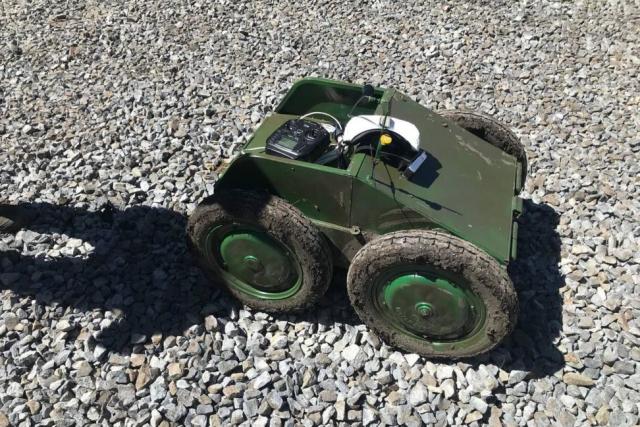 |
| Combat robotic platform "Miner BR-1". |
| Source: © Telegram-channel "Combat robots" |
In addition, the robot "Miner BR-1" is used in the special operation. As the name implies, the device is designed for setting minefields. Seven such products have already been delivered to the SVO zone.
"The complex takes a mine, drops it and leaves, having mined a certain area. Unloading turns out to be neat, the side drops quite low, the "Miner" drives off — and the ammunition is carefully placed. In addition, if suddenly the fighters ran out of ammunition, with the help of this platform it is possible to safely deliver them to the servicemen," the agency interlocutor said. The machine is optimized for the delivery of goods weighing up to 70 kg, has a maximum load capacity of 150 kg.
In addition, the developer of the platform — the Russian scientific and production association, the name of which is not disclosed - has created a "Miner"—kamikaze, a one-time version of the device.
According to a TASS source, BRG-1 and Miner BR-1, which can receive artificial intelligence, use Russian components by 90%.
Attack robots
In addition to unarmed robots, a ground-based robotic BR-2 platform is involved in a special military operation, on the mobile turret of which an automatic rifle, a Kalashnikov machine gun, a grenade launcher and even an anti-tank missile system can be installed. It is used by Russian assault units.
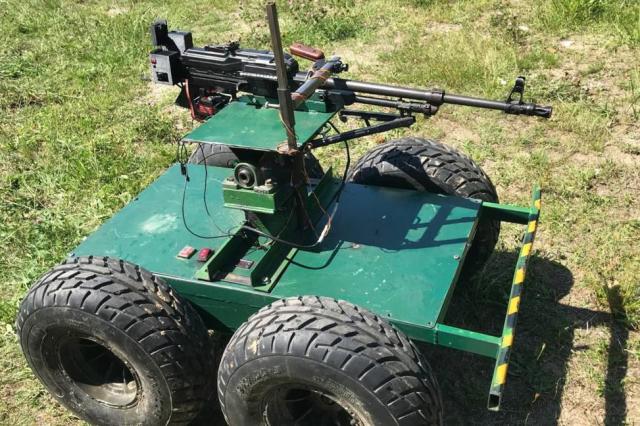 |
| The BR-2 robotic platform. |
| Source: © Telegram-channel "Combat robots" |
"The use of the complex provides soldiers with security during offensive actions, for example, when the enemy is protected by embrasures. If it is necessary to make a run from one building to another, the platform can both attack independently and be used as a cover for Russian fighters," the agency source said, adding that the BR—2 can also be used for cargo transportation.
Another robotic complex that can be used for both reconnaissance and enemy attacks is the wheeled reconnaissance and strike vehicle "Hedgehog" developed by the design bureau "Spectrum" from Novosibirsk. Andrey Bratenkov, executive director of the developer company, told TASS about the delivery of the prototype to the SVO zone.
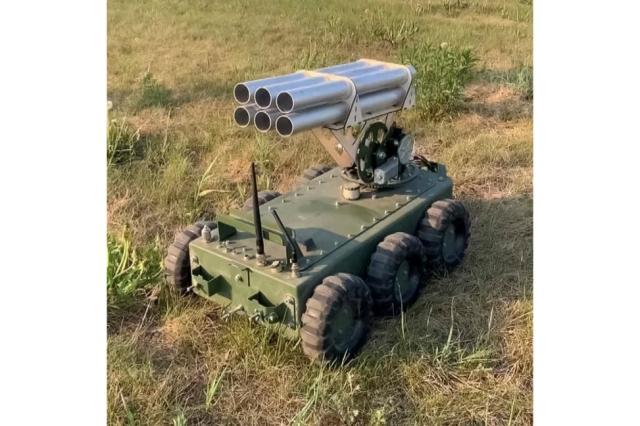 |
| Ground drone "Hedgehog". |
| Source: © Ekaterina Adamova/ TASS |
In the current version, the "Hedgehog" is designed to identify enemy firing points, provoking them with bright lighting. The device can move away from the operator by 5 km and carry a payload of up to 5 kg. The developers plan to place a launcher for advanced ammunition on the platform. With their help, the attack robot will be able to hit the enemy's defenses, getting close to them, while not putting the lives of Russian fighters at risk.
Robots-Red Army soldiers
Ground-based uninhabited vehicles (NNA) appeared on the battlefields more than a decade ago. For example, back in 1939, two battalions of remotely controlled armored vehicles — teletanks, which were used during the Soviet-Finnish War, were created in the Soviet Union. At the beginning of the Great Patriotic War, Soviet engineer and science fiction writer Alexander Kazantsev, author of the novels "The Burning Island" and "Planet of Storms", designed an electric kamikaze tankette. The tracked "land torpedo" was successfully used to undermine fortified Fascist long-term firing points.
The Soviet Union's positions in robotics have always been strong. The Soviet self-propelled vehicle Lunokhod-1 in 1970 became the first planetary rover to successfully operate on the surface of another celestial body. The technologies developed during the creation of the "Lunokhods" were used during the liquidation of the consequences of the accident at the Chernobyl nuclear power Plant (Chernobyl NPP) in 1986. Strong radiation on the roof of the fourth power unit of the station, destroyed by the explosion, in 20 minutes. It disabled the electronics of the newest German robotic complex "Joker", while the Soviet special remote-controlled robot STR-1 managed to clear radioactive debris in the most dangerous areas. In the territories adjacent to the emergency station, another device was working — "Klin-1", developed by specialists in 44 days on the basis of a heavy tracked engineering vehicle of the IMR-2 barrier.
The largest disaster in the history of nuclear energy stimulated the development of domestic robotic systems designed to work in extreme conditions. Currently, the Armed Forces of the Russian Federation have a line of heavy uninhabited tracked vehicles for demining territories, extinguishing complex fires, as well as other special robotics. The Uran-6 NPA is known for its work in Syria and Nagorno-Karabakh, where with its help Russian sappers defused extensive minefields. "Uran-14" eliminated the ignition of an ammunition depot near Achinsk in 2019.
On the way to the Terminator
Unlike unmanned aerial vehicles, which are massively used in modern military conflicts, ground-based robotic systems are less common on the battlefield. Andrey Bratenkov, in an interview with TASS, expressed the opinion that there are no technical and technological difficulties in creating an NNA. According to him, devices of this type are in demand, but their spread is hindered by the lack of funding, effective measures to support developers. Earlier, the specialist noted that the development of the Hedgehog robot was carried out on an initiative basis and was partially funded by military personnel of special purpose units who planned to use this NPA.
The developers are in constant contact with the fighters on the front line using their devices. Currently, Spectrum is engaged in the organization of a satellite communication channel in order to receive feedback on the use of its devices.
The design bureau is developing autonomous ground-based and aviation robotic systems, inertial navigation systems (INS) resistant to electronic warfare, control integration with machine vision and artificial intelligence (AI).
Alexander Sergeev, Director General of the Federal Center for Applied Development of Artificial Intelligence, told TASS on the sidelines of the Army-2023 forum that Russia has technologically come close to creating intelligent combat robots like the Terminator.
"We have robots that independently perform combat missions, as well as unmanned aerial vehicles," Sergeyev said in response to a question whether AI technologies will be able to influence the course of a special military operation. According to the expert, full autonomy for such robotic tools will come when they are taught to make the right decisions independently, even in the absence of communication with the operator. "This is the use of artificial intelligence in various defensive and offensive complexes," he stressed.
Victor Bodrov
